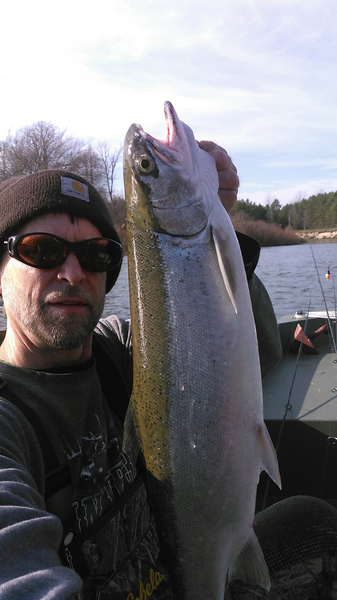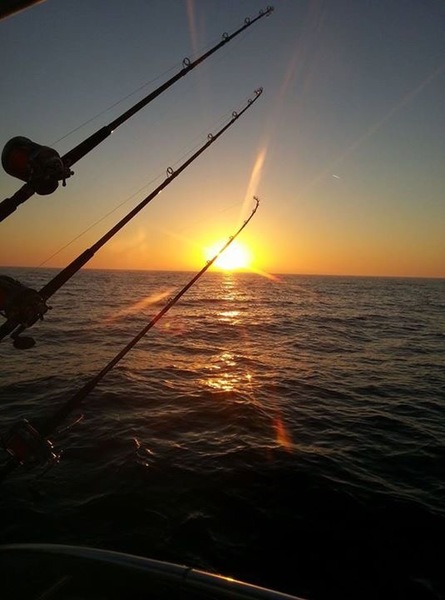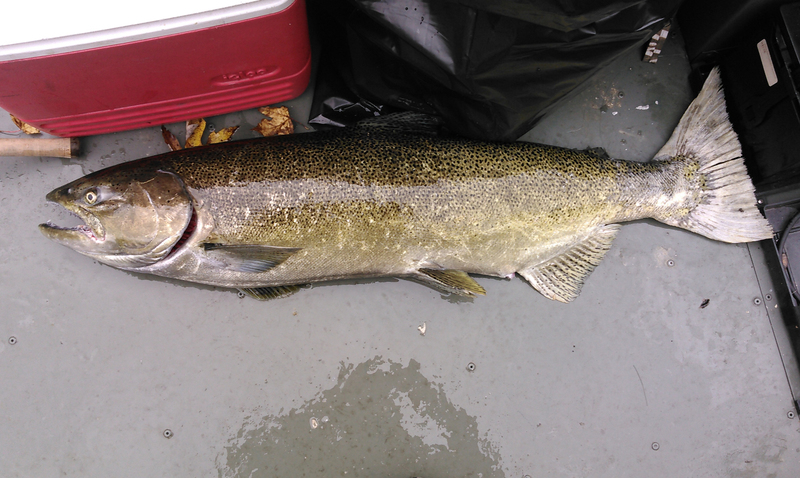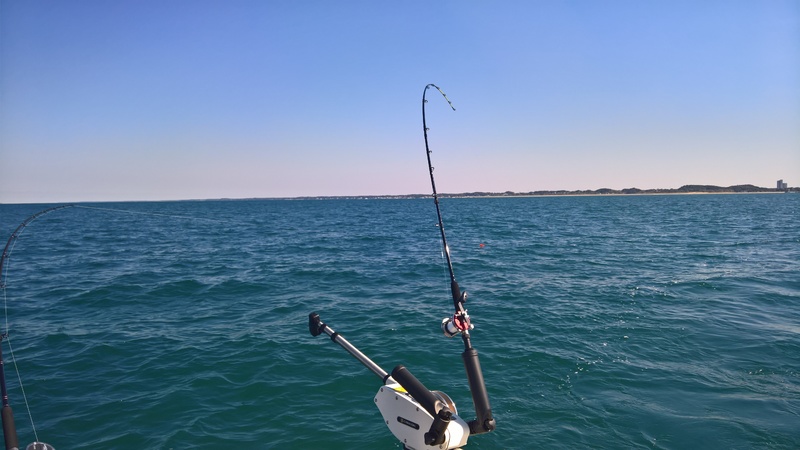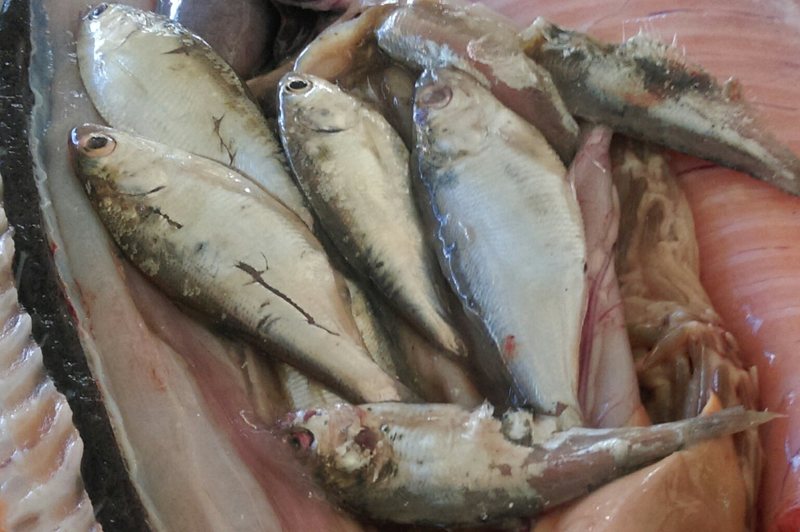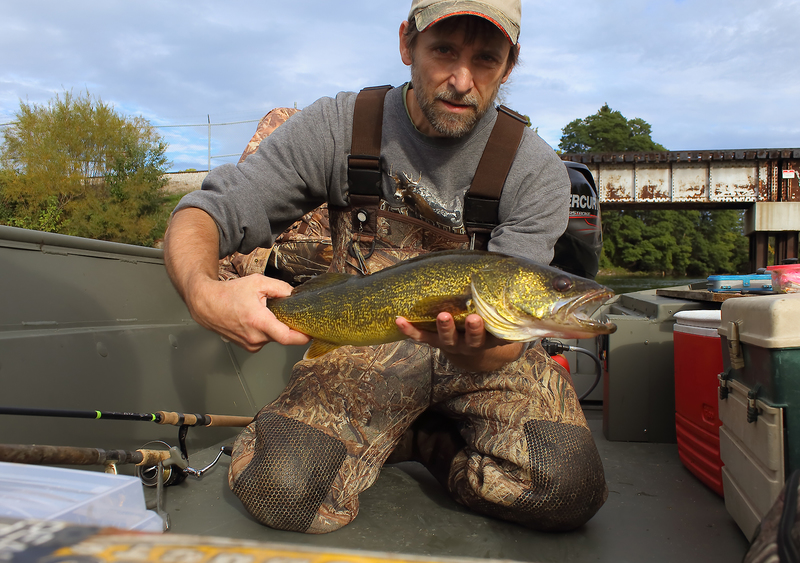-
Posts
2,817 -
Joined
-
Last visited
Content Type
Profiles
Forums
Events
Store
Gallery
Everything posted by EdB
-
Happy New Year! Sent from my SM-G920V using Great Lakes Fisherman Mobile App
- 1 reply
-
- 1
-

-
May he rest in peace.
-
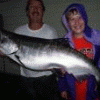
North East and Happy Thanksgiving!
EdB replied to phishtix's topic in Lake Huron Pier and River Reports
-

Holland am, 11-15-16
EdB replied to littleboat's topic in Michigan Waters Fishing Reports - Salmon and Trout
Great catch! Sent from my SM-G920V using Great Lakes Fisherman Mobile App -
Water sure is warm for November. Sent from my SM-G920V using Great Lakes Fisherman Mobile App
-
-

Holland pm, 10-27-16
EdB replied to littleboat's topic in Michigan Waters Fishing Reports - Salmon and Trout
It does look a bit chilly, nice catch. Sent from my SM-G920V using Great Lakes Fisherman Mobile App -

Muskegon - 10/22
EdB replied to Fish Tank's topic in Michigan Waters Fishing Reports - Salmon and Trout
Nice job on the steelhead! Sent from my SM-G920V using Great Lakes Fisherman Mobile App -

Muskegon - 10/22
EdB replied to Fish Tank's topic in Michigan Waters Fishing Reports - Salmon and Trout
Thanks for the report. Sent from my SM-G920V using Great Lakes Fisherman Mobile App -
Welcome to GLF! Sent from my SM-G920V using Great Lakes Fisherman Mobile App
-
http://dnr.wi.gov/news/releases/article/?id=4092 Sent from my SM-G920V using Great Lakes Fisherman Mobile App
-
It sure is tough to net a 20lbr in a river by yourself. I struggle doing that with a 8lb steelie sometimes.
-

MIchigan City 10/9/2016
EdB replied to scoffer's topic in Indiana Waters Fishing Reports - Salmon and Trout
-
Here are the press releases issued today. LMC news release salmon and trout stocking 10-11-16.pdf Trout and Salmon Stocking Adjustments for Michigan Waters of Lake Michigan - Final- Oct 11 2016.pdf FISHERY AGENCIES ADJUST LAKEWIDE PREDATOR STOCKING TO PRESERVE LAKE MICHIGAN PREDATOR-PREY BALANCE Agencies seek to sustain diverse salmon and trout fishing opportunities into the future ANN ARBOR, MI – In response to persistent and comprehensive evidence of declining pelagic prey fish abundance, the Lake Michigan Committee today proposed stocking reductions to better balance trout and salmon predators with their pelagic prey for 2017, while also sustaining Lake Michigan’s diverse trout and salmon fishery. The five-member Lake Michigan Committee comprises all state management agencies that border Lake Michigan and the Chippewa-Ottawa Resource Authority. Recommendations from the committee represent the consensus of its members. The stocking adjustments, which would commence in spring 2017, underscore the committee’s shared commitment to sustain Lake Michigan’s prized salmon and trout fishery as the lake’s ecosystem shifts. Extensive changes to the lake’s food web, driven primarily by invasive species such as quagga and zebra mussels, have reduced the amount of food available for pelagic prey fish like alewife and rainbow smelt. Other ecosystem changes include enhanced natural reproduction of key predators, especially Chinook salmon, and increasingly lake trout, which intensifies the pressure on a declining pelagic prey fish community. Ongoing research by the U.S. Fish and Wildlife Service and state partners indicate that natural reproduction currently accounts for more than 60 percent of all Chinook salmon in Lake Michigan. After engaging with respective governments, recreational anglers, charter fishers, partner agencies, community leaders and others, Lake Michigan Committee members will relieve pressure on prey fish by reducing salmon and trout stocking by the predator equivalent of more than 800,000 Chinook during 2017 and the predator equivalent of more than 900,000 Chinook in 2018 to provide sustainable and diverse fishing opportunities throughout the lake. Lakewide stocking of 1.32 million Chinook salmon will occur in 2017 -- a Chinook reduction of 27 percent -- recognizing that naturally produced Chinook salmon sustain much of the existing Chinook salmon fishery. Lakewide lake trout stocking will be 2.74 million in 2017, a 12 percent reduction. In 2018, 2.54 million lake trout will be stocked. Under this consensus, each jurisdiction will have the ability to adjust stocking levels of certain species using "Chinook salmon equivalents" within its waters to meet the lakewide commitment to better balance predators with their prey. This approach to balancing the predatory demand on alewives and other pelagic prey fish will assist the Lake Michigan Committee with its goal to sustain a diverse salmon and trout fishery while simultaneously supporting its ongoing commitment to lake trout rehabilitation. "We know from past experiences that these steps will enable us to follow through on our commitment to meet Fish Community Objectives for a multi-species salmon and trout fishery," said Lake Michigan Committee Chair Jay Wesley, of the Michigan Department of Natural Resources. "Carrying out these shared objectives has proven extremely challenging for our member management agencies. However, we believe this consensus stocking strategy, in conjunction with the growing contribution from natural reproduction of Chinook salmon and lake trout, will maintain a more stable predator – prey balance, and support diverse and sustainable fishing opportunities in Lake Michigan." Wesley said each state will implement the Lake Michigan Committee guidance with its own strategy in a spirit of collaboration consistent with the committee’s recommended framework. To monitor effects of the stocking adjustments during 2017 and 2018, and to allow fishery managers to respond to changing conditions in the lake, the Lake Michigan Committee and partner entities will annually conduct comprehensive research and monitoring to evaluate the lake’s predator balance with its prey. These assessment efforts will produce a suite of biological indicators composed of long-term and short-term data collected and analyzed by state, federal, tribal and academic experts throughout the Lake Michigan basin. This collaborative process represents the best available science to promote sustainable and diverse fisheries for Lake Michigan. The Lake Michigan Committee comprises fishery managers from the Chippewa-Ottawa Resource Authority, Indiana, Illinois, Michigan and Wisconsin. The Lake Michigan Committee’s work is facilitated by the Great Lakes Fishery Commission, a Canadian and U.S. agency on the Great Lakes. The committee meets regularly to share information and develop shared fishery management plans, objectives and policies. For more information, visit the Lake Michigan Committee online at www.glfc.org/lakecom/lmc/lmchome.php. CONTACTS: Marc Gaden, Great Lakes Fishery Commission, 734-669-3012 Jay Wesley, Lake Michigan Committee Chairman, Michigan, 269-685-6851 Brad Eggold, Wisconsin, 414-382-7921 Tom Gorenflo, Chippewa-Ottawa Resource Authority, 906-632-0072 Jeremy Price, Indiana, 260-244-6805 Vic Santucci, Illinois, 847-294-4134 FOR IMMEDIATE RELEASE October 11, 2016 Contact: Jay Wesley, 269-685-6851 Ext. 117 or Ed Golder, 517-284-5815 DNR announces stocking adjustments for Michigan waters of Lake Michigan Following recommendations of the Lake Michigan Committee, the Department of Natural Resources will adjust Chinook salmon and lake trout stocking in 2017 and 2018 to relieve predation pressure on prey (alewives) in Lake Michigan. This will be the fourth significant stocking adjustment to predator levels since 1999. The five-member Lake Michigan Committee is made up from all state management agencies that border Lake Michigan and the Chippewa-Ottawa Resource Authority. Recommendations from the committee represent the consensus of its members. The committee worked throughout the summer with interested anglers and constituents to amend a proposal that had substantially targeted only a Chinook salmon reduction to today’s recommendation to reduce a mix of species to achieve the same reduction in predation pressure in Lake Michigan while recognizing the importance of Chinook. "We received a considerable amount of comments from our advisory committee, sporting groups, anglers and the general public on how to address the predation issue," said Jay Wesley, DNR Lake Michigan Basin coordinator. "The one common goal we all shared through the review process was to maintain our diverse fishery in Lake Michigan with Chinook salmon as an important component of our multi-billion dollar sport fishery." While most of the stocking adjustments will occur in other states, Michigan will stock 300,000 Chinook salmon in 2017 (down 46 percent from 2016) and will discontinue federally stocked lake trout in Grand Haven, Holland and New Buffalo in 2018. Lake Michigan’s Chinook fishery is supported by 60 percent wild fish that are mostly produced in Michigan’s rivers and streams. Michigan will also continue to stock 1.57 million coho salmon, 580,000 steelhead and 550,000 brown trout to maintain a diverse fishery. In the near future, Michigan will eliminate its own stocking of lake trout in Lake Michigan (50,000) and replace these fish with steelhead. "We appreciate the robust engagement Michigan citizens brought to this issue," said DNR Fisheries Division Chief Jim Dexter. "They learned more about the difficulty managing Lake Michigan, and we learned more about their fishing preferences. In the end, we will still meet our biological goal to reduce predation pressure and continue to provide a world-class fishery." Michigan will continue to work with our anglers, state, tribal and federal partners to collect and evaluate wild fish recruitment, charter boat and creel success rates, prey fish and predator abundance to determine when salmon stocking might be increased. "Data on predator and prey numbers, salmon weight and salmon condition (health) are considered annually to determine when it is safe to increase stocking in the future," said Wesley. The DNR is committed to collaborative management of Lake Michigan management agencies and anglers alike to maintaining a diverse, world-class fishery. These actions in Michigan and in other jurisdictions will help protect our fishery and the economies throughout Michigan that depend on it. Learn more about the changing ecology of Lake Michigan and its impact on salmon by watching a video on YouTube. (https://www.youtube.com/watch?v=wLiG4wwYM6M) For additional information, visit the DNR"s salmon web page. (http://www.michigan.gov/dnr/0,4570,7-153-10364_52259-323650--,00.html)
-
-

Holland pm, 10-9-16
EdB replied to littleboat's topic in Michigan Waters Fishing Reports - Salmon and Trout
Couple nice chromers there! -
That's awesome you got a reward tag! I'd be thrilled with jaw tagged eye. I have never got one.
-
-
-
I regret some of us may disagree on this my friends. Please know the GLSI is striving for the same goal most of you have which is a healthy, long term, balanced, multi specie fishery in Lk Michigan that our kids and grandkids can enjoy like we do. We respect the science and there is nothing in our proposals that go against the current science on Lk Michigan. The GLSI is not advocating for no plant cuts. MDNR and the science say we need to reduce predation on alewives. We agree. The MDNR made a huge king cut 3 years ago and it seems to be working. The number of kings in the lake has dropped dramatically and it’s proven by weir returns in 2014, 2015 and so far this year. The size of the kings increased dramatically in 2016 but overall numbers are still at historic lows. All the sport fish species in 2016 are healthy and much larger than recent years. We have had 2 back to back solid year classes of alewives. We still agree the forage base is at risk. We think most anglers would prefer a balanced fishery with a good chance to catch some kings. We remain concerned that the goals of the MDNR and Feds for Lk Michigan do not align with what we the anglers who fund them want. When you read the Feds and MDNR’s lake tout restoration plan, you will see what I mean. They have agreed to it and have been implementing this plan. I have the full report in PDF version and will be glad to email it to anyone if you PM me your email. Here is some info taken from this report. "Lake trout need to become more of a dominant predator in the fish community in areas targeted for restoration. Strategies that reduce the occurrence of alewife in the diet of Lake Michigan lake trout or decrease the availability of thiaminase to alewife need to be developed or poor survival of lake trout fry will continue to hinder the restoration effort in Lake Michigan. Stocking should be increased as much as possible beyond the current level (2005) of 2.4 million lake trout per year. Natural reproduction of lake trout is occurring" Does the angling community and fishing industry around the great lakes want lake trout to become the dominant predator in Lake Michigan? We have had two back to back large year classes of alewives. It is interesting the science we have did not predict this. They did not foresee the dramatic increase in the size of the fish this season. That is because the science behind this is far from settled and relies on computer models and forecasting that is far from perfect. It is also interesting that when the GLSI requested all the raw data gathered in the forage surveys, such as GPS locations, transects, dates and time of the surveys, they would not give it to us. What is there to hide? Don’t we pay for this research? This spring, researchers made requests through the internet and social media for anglers to send in photo’s of our depth finders showing bait and the date, time and GPS location. They wanted to assess if their survey locations were in places where anglers are seeing lots of bait. That was shut down by higher up bureaucrats a few weeks later. Why if they truly want to assess the validity of the current science and location of their surveys? The king population is at historic lows after the last round of cuts and their size is up dramatically. It indicates they have a lot of food for the current population. King catch rates are at historic lows. On the other hand, lake trout catch rates are the highest they have ever been in years. Yet they don’t want to cut lake trout and want to hammer king plants another 50%. The token lake trout cuts currently proposed are only for fall fingerlings which have poor survival so the cut is really not much at all. They are not cutting any of the 18 month old yearlings that have a high survival rate due to their size. They eat young alewives. Cutting those would be a meaningful cut that would protect alewives in the first year. There has been talk about relying on natural reproduction for our king fishery. I ask two questions about that. If the natural reproduction is so good, why did the king fishery drop so much in the years after the plant cuts? Shouldn’t all the natural fish have filled the void? The king returns to our rivers are at historic lows the last 2 years. The Little Manistee Weir got 654 kings back last year. The average for the 10 prior years was 9000+ kings and even higher prior to that. I just checked weir counts for this season. They did one egg take, spawned 108 pairs, got a total of 889 kings, many were immature jacks and now they are waiting for more fish to arrive to schedule the next egg take. How many more fresh kings from the lake will come up after Oct 6th? I doubt many. This river has primo spawning habitat but it clearly did not spawn many fish to produce these dismal runs. How many will smolt this spring from these low numbers returning this year? It looks like a second year in a row with a cut of naturally spawned kings. We don’t think we can rely on natural reproduction alone to sustain our king fishery. If you want all planting stopped, you need to get organized and lobby your position to the DNR because they and the scientists don’t want that now. We do have some skepticism about the science but accept that we should reduce predation on the forage base by reducing plants to protect it long term. We feel the past king cuts worked as intended and did just that. We want a balanced fishery, not all kings, not all lake trout, a mix of all 5 species is ideal. Since kings have taken numerous cuts in past years, we want cuts to lake trout this spring to balance the predator base and protect our forage base. They just need to figure how many lake trout they need to cut to equate the forage protection a 50% king cut would do and cut that many trout. If that is done, we can protect the same amount of forage as the proposed king cuts would do and not cut kings for one more year to assess past cuts. That is supporting current science. It is just a different approach to achieve the same results. I can live with a least a chance to catch a couple kings a trip. There was a number of trips this year were we never caught a king. All in all, the last 2 years have been the worst fishing in my entire life but I can live with what we have. If the king fishery declines anymore, getting up at 4AM is not going to be worth it. I and many others won’t do that for lake trout. It will have a negative impact on the economies of all the lakeshore communities. If we keep planting the numbers of lake trout we are right now, they can wipe out the alewives as fast as kings. When you read the lake trout restoration plan maybe that is the intent? Plant so many lake trout that don’t die for 20 years, create an ever expanding population, create a predator pit of lake trout, wipe out the alewives and then we’ll have a self sustaining lake trout population in Lake Michigan. Along with it goes the king fishery, the fishing industry and supporting businesses up and down the coast. All you have to do is look at Lake Huron to see how devastating it was there. Nobody is flocking there to target lake trout. The goal to restore lake trout is a noble one and it has happened in Huron and Superior. With the change in the forage base, priorities for Lake Michigan need to be adjusted. The goal to restore lake trout and maintaining a vibrant king fishery may not go well together. I think most anglers would prefer Lk Michigan is managed for salmon as the top predator and not lake trout. Lake trout should be a component of the fishery but they should not dominate the lake. We already have great trout fisheries in Superior and Huron. If we cut enough lake trout in 2017 to protect the same amount of alewives that the current 50% king cut would do, than we are supporting the current science and just offering an alternative to achieve the same goal. Cutting trout protects alewives for 10-20 years instead of 3 years with kings. Let’s see what happens in 2017 and then re-evaluate what is needed for 2018. That is what the GLSI is fighting for. I hope some of you will join us.
-

Holland AM 10-6
EdB replied to Copilottruman's topic in Michigan Waters Fishing Reports - Salmon and Trout
Nice catch! Sent from my SM-G920V using Great Lakes Fisherman Mobile App -

Grand Haven 10/4 pm
EdB replied to mrhookup's topic in Michigan Waters Fishing Reports - Salmon and Trout
-

Holland 10/4 AM
EdB replied to Dr Hook's topic in Michigan Waters Fishing Reports - Salmon and Trout
Nice catch, looks like you finished strong after the slow start. Sent from my SM-G920V using Great Lakes Fisherman Mobile App -
The lake trout are reared to a much larger size than salmon when stocked and they are eating alewives in their first year. We already got a cut in naturally spawned kings this spring from the dismal runs in the fall of 2015. Since we stock twice as many lake trout as kings, if we cut planting lake trout completely for one year except those required due to the consent degree, it would have a much larger positive impact on bait than the currently proposed king cuts. There is a lot more lake trout mouths available to cut than kings. The stocking strategies are way out of whack and we are planting far to many lake trout. We recognize the science and can protect the same number of alewives annually by drastically cutting the number of lake trout. You could skip the entire plant of them in 2017, except those required by the consent degree and the fishery would not miss a beat due to their high population and multiple age classes. Keep in mind, lakers don't die every three years so their numbers grow exponentially every year. Those laker plants keep eating alewives in years 2,3,4,5,6,7,8,9,10 and older. Anybody who targeted them in the past couple years can attest to their over the top numbers.


